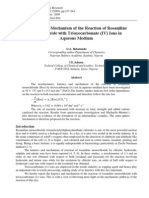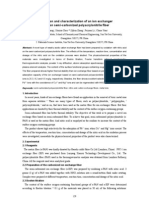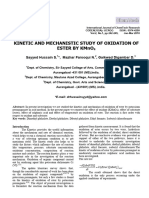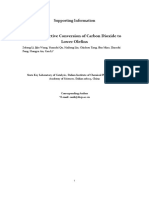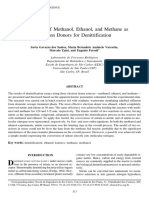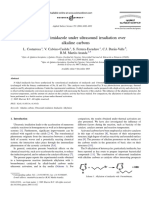Studies On Manganese (Ii) Catalyzed Oxidation of N-Methylaniline by Periodate Ion
Studies On Manganese (Ii) Catalyzed Oxidation of N-Methylaniline by Periodate Ion
Uploaded by
Yuda AryokoCopyright:
Available Formats
Studies On Manganese (Ii) Catalyzed Oxidation of N-Methylaniline by Periodate Ion
Studies On Manganese (Ii) Catalyzed Oxidation of N-Methylaniline by Periodate Ion
Uploaded by
Yuda AryokoOriginal Title
Copyright
Available Formats
Share this document
Did you find this document useful?
Is this content inappropriate?
Copyright:
Available Formats
Studies On Manganese (Ii) Catalyzed Oxidation of N-Methylaniline by Periodate Ion
Studies On Manganese (Ii) Catalyzed Oxidation of N-Methylaniline by Periodate Ion
Uploaded by
Yuda AryokoCopyright:
Available Formats
Int. J. Chem. Sci.
: 8(3), 2010, 1379-1388
STUDIES ON MANGANESE (II) CATALYZED OXIDATION OF N-METHYLANILINE BY PERIODATE ION
R. D. KAUSHIK*, MANMEET KAUR, RAJDEEP MALIK and ANUJ KUMAR
Department of Chemistry, Gurukul Kangri University, HARIDWAR - 249404 (U.K.) INDIA
ABSTRACT
The kinetics of the periodate oxidation of N-methylaniline (NMA) in acetone-water medium has been followed by monitoring the increase in the absorbance of reaction intermediate, C4, and the main reaction product is p-benzoquinone. Results under pseudo first order conditions, [IO4-] >> [NMA], are in agreement with the rate law: d[C]/dt = kK3K4Kw[MnII] [S] [IO4]0 [H+] /{K2 Kw + (Kw + Kb K2 )[H+] + Kb [H+]2} where kK3K4 is the empirical composite rate constant, Kw is ionic product of water, K2 is acid dissociation constant of H4IO6, Kb is base dissociation constant of NMA i.e. Substrate [S] and [IO4]0 represents the concentration of periodate that has been taken in excess in most of the kinetic runs. In agreement with the rate law, the 1/kcat versus [H+] profile passes through the minimum. Free radical scavengers do not affect the reaction rate. Thermodynamic parameters evaluated are: Ea = 5.2 kcal mol-1, A = 4.79 109 dm3 mol-1 s-1; S# = 16.3 cal mol-1, G# = 9.7 kcal mol-1 and H# = 4.6 kcal mol-1. Key words: Kinetics, MnII catalysed, Periodate, n-Methylaniline, p-Benzoquinone.
INTRODUCTION
Keeping in view our earlier studies on uncatalysed periodate oxidation1-8 and a few reports available on the kinetic studies for the MnII catalyzed non-Malapradian periodate oxidation of aromatic amines9-12, the kinetic-mechanistic studies have been made on Mn (II) catalysed periodate oxidation of N-methylaniline (NMA). The results of these studies in acetone-water medium are presented and discussed in this communication. The studies are important for their further expected use in developing methods for detection and treatment of the aromatic amines the chemicals enlisted as toxic13.
________________________________________
*
Author for correspondence; E-mail: rduttkaushik@yahoo.co.in
1380
R. D. Kaushik et al.: Studies on Manganese.
EXPERIMENTAL
Reagents and chemicals
Sodium metaperiodate (Loba Chemie), NMA (Aldrich), acetone (E. Merck), manganese sulphate monohydrate (Aldrich) and all other chemicals of analytical reagent/ guaranteed reagent grade were used after redistillation/ recrystallization. Triply distilled water was used for preparation of the solutions. Thiel, Schultz and Koch buffer14, consisting of different volumes of 0.05 M oxalic acid, 0.02 M boric acid, 0.05 M succinic acid, 0.05 M sodium sulphate and 0.05 M borax, was used for maintaining the pH.
Kinetic procedure
The reaction was studied in a spectrophotometric cell and initiated by adding temperature equilibrated NaIO4 solution of known concentration to the reaction mixture containing the NMA, MnII and buffer and maintained at the desired temperature ( 0.10C). The progress of the reaction was followed by recording the absorbance on Schimadzu double beam spectrophotometer (UV Pharmaspec-1700), at 533 nm, i.e., the max of the violet color reaction mixture. max was not found to change with change in time under experimental conditions. Desired temperature was maintained with the help of a high precision thermostatic control.
Product analysis
Reaction mixture containing oxidant in excess was left overnight to ensure completion of the reaction. Initially, the solution turned violet, thereafter reddish brown and finally the solid product settled down on standing. It was filtered and the filtrate was extracted with petroleum ether (40-60oC). The extract was evaporated at room temperature to get a solid yellow residue that was found to be TLC single (using plate thickness of 0.5 mm, silica gel G as adsorbant, chloroform+ acetone+ benzene in the ratio 4 : 6 : 4 mL used as eluent and 30 minutes as the time for development). The remaining part of filtrate may be having other products of this reaction, which could not be separated and identified. The yellow crystalline compound was recrystallised in ethanol and characterized as pbenzoquinone on the basis of positive test for quinone15, M.P. 116oC (literature value 115117oC16), UV spectrum in ethanol giving absorption maxima at 240, 280 and 440 nm, suggested the presence of quinonoid structure in the compound (literature values 244, 280 and 436 nm 17). The IR spectrum of this compound (in KBr) showed the presence of bands at 1645 cm1 (s) (indicating the presence of C=O on benzoquinone pattern18), 3280 cm1(s) (may be due to overtones of C=O stretch as the frequency is about twice that of C=O stretch).
Int. J. Chem. Sci.: 8(3), 2010
1381
Further, the bands at 1470 cm-1 (s) may be due to due to C=C ring stretch, 1365 cm1 (m) and 1100 cm1 (m) may be due to in plane C-H bending. The bands at 830 cm1 (m) (due to out of plane C-H bending in case of two adjacent H atoms) and 680 cm1 (m) (due to out of plane C=C bending mode) were also obtained.
Stoichiometry
Stoichiometry of the reaction was determined by allowing a known excess of NaIO4 to react with substrate. After completion of the reaction, the precipitated product was filtered out and in the filtrate, unconsumed NaIO4 was determined iodimetrically. The results indicated the stoichiometry to be 1 mol NMA : 2 moles periodate for the initial part of the reaction as in eq. (1).
C6H5NHCH3 + 2 IO4 + 2 H+ + H2O
Mn II
C6H4O2 + 2 HIO3 + NH3 + CH3OH
...(1)
RESULTS AND DISCUSSION
Preliminary observations
On mixing the reactants, the solution becomes violet, which later changes into reddish brown. On keeping for long time, it finally gives the product. These observations indicate the formation of more than one intermediate prior to the formation of final reaction product. The rapid scan of the violet solution showed the max of the intermediate, C4, to be 533 nm. The UV-visible spectra of IO4, NMA and MnII indicated that these do not show absorption in visible region. Hence, for following the kinetics, the absorbance changes were recorded at 533 nm at which only the intermediate C4 absorbs.
Rate law
The kinetics was studied under pseudo-first order conditions by keeping periodate concentration in excess. Guggenheims method was used for evaluation of pseudo-first order rate constants, kobs. Under these conditions, the kinetics was defined by the rate law (2). d[C]/dt = kcat [S] [IO4-]0 [MnII] ...(2)
where kobs = kcat [IO4-]0 [MnII] and kcat is the rate constant for MnII catalysed pathway. [IO4-]0 represents the initial concentration of periodate that has been taken in excess. In the absence of MnII, no significant reaction occurred. The values of kcat obtained for different [MnII], [IO4]0 and [S] are seen to be in good agreement and consistent with the rate law (2) (Table 1, Fig. 1).
1382
R. D. Kaushik et al.: Studies on Manganese.
Table 1: Values of kobs and kcat at 35 0.1oC
[NaIO4] (mol dm-3) 0.0002 0.0002 0.0002 0.0002 0.0002 0.003 0.004 0.005 0.003 0.003 0.003 0.003 0.003 0.003 0.003 0.003 0.003 0.003 0.003 0.003 0.003 0.003 0.003 0.003 0.003 0.003 [NMA] [Mn (II)] 107 (mol dm-3) (mol dm-3) 0.002 0.003 0.004 0.005 0.006 0.0003 0.0003 0.0003 0.0003 0.0003 0.0003 0.0003 0.0003 0.0003 0.0003 0.0003 0.0003 0.0003 0.0003 0.0003 0.0003 0.0003 0.0003 0.0003 0.0003 0.0003 1.456 1.456 1.456 1.456 1.456 6.0 6.0 6.0 1.456 2.912 4.368 5.824 7.280 1.456 1.456 1.456 1.456 1.456 1.456 1.456 1.456 1.456 1.456 1.456 1.456 1.456 Acetone [% (v/v)] 5.0 5.0 5.0 5.0 5.0 10.0 10.0 10.0 10.0 10.0 10.0 10.0 10.0 10.0 10.0 10.0 10.0 10.0 10.0 10.0 10.0 10.0 2.5 5.0 7.5 10.0 pH 6.0 6.0 6.0 6.0 6.0 6.0 6.0 6.0 6.0 6.0 6.0 6.0 6.0 4.0 4.5 5.0 5.5 6.0 6.5 7.0 7.5 8.0 6.0 6.0 6.0 6.0 kobs 104 (s-1) 3.99 5.60 7.06 8.32 9.47 24.6 31.5 37.6 5.37 10.05 16.00 21.30 26.60 3.11 4.22 4.57 4.68 5.37 9.15 6.29 4.40 3.93 7.68 6.83 5.99 5.37 kcat 10-7 (dm6 mol-2 s-1) 0.140 0.130 0.120 0.110 0.110 0.136 0.131 0.130 0.123 0.115 0.122 0.122 0.122 0.071 0.097 0.104 0.107 0.123 0.210 0.144 0.100 0.090 0.180 0.160 0.140 0.123
Int. J. Chem. Sci.: 8(3), 2010
1383
0.0050 0.0045 0.0040
kobs
0.0035 0.0030 0.0025 0.0020
0.0000002
0.0000004
0.0000006
0.0000008
Mn (II)
Fig. 1: Effect of [Mn(II)] on reaction rate at [NMA] = 3.0 10-4 mol dm-3, [NaIO4] = 3.0 10-3 mol dm-3, pH = 6.0, Acetone = 10.0 % (v/v), Temp. = 35 0.1C
Effect of pH, ionic strength, acetone, free radical scavengers and temperature
The effect of pH was examined in the range 4.0-8.0. 1/ kcat [H+] profile indicates a minimum at pH = 6.5 (Table 1, Fig. 2), which could be due to change in the nature of species and their relative reactivity, when the pH is changed. An increase in ionic strength caused almost no effect on the rate. An increase in the acetone (2.5-10.0%) led to about 39% decrease in the rate. Free radical scavengers, viz., acrylamide and allyl alcohol had no effect on the reaction rate. By determining the rate constants at four different temperatures (35.0 to 50.0oC), the values of different thermodynamic parameters were found and these are given in Table 2. Preliminary examinations reveal that faster colour changes in the reaction mixture relative to the separation of product on standing for long time indicates the formation of the colored intermediate on a time scale of minutes and that of the final product on a time scale of hours. The overall reaction appears to involve several steps and possibly several transient intermediates, in addition to comparatively stable one C4, during the oxidation of NMA into p-benzoquinone. Further, the kinetic order of one in periodate against the requirement of two periodate molecules for each NMA molecule in the stoichiometry (Eq. 1) requires the involvement of only one periodate in the rate determining step and second IO4 ion to be consumed in a fast step leading to the formation of the intermediate, C4. Since the concentration of C4 increases continuously with time and reaches a limiting value, its
1384
R. D. Kaushik et al.: Studies on Manganese.
concentration can not be in steady state. Finally, 1/ kcat [H+] profile indicates the presence of at least three differently reactive reactant species in the pH region chosen for study. Finally, the observation that free radical scavengers have no effect on reaction rate rules out the involvement of free radicals in the oxidation mechanism. Table 2: Activation parameters
[NMA] =3.0 10-4 mol dm-3, [NaIO4] = 3.0 10-3 mol dm-3, [MnII] = 1.456 10-7 mol dm-3, Acetone = 10.0 % (v/v), pH = 4.5 Temp. (oC) 35 40 45 50 104 kobs 10-7 kcat (dm6 mol-2 s-1) (s-1) 4.22 4.84 5.53 6.29 0.097 0.111 0.127 0.144 5.2 4.8 109 - 16.3 9.7 4.6 Ea (kcal mol-1) A (dm3 mol-1 s-1) S# (cal mol-1) G# (kcal mol-1) H# (kcal mol-1)
14 12
1/kcat x 10
10 8 6 4
200
+
400
7
600
-3
800
1000
[H ] x 10 mol dm
Fig. 2: Effect of [H+] on the rate at Acetone = 10% (v/v), [NMA] =3.0 10-4 mol dm-3, [NaIO4] = 3.0 10-3 mol dm-3, [MnII] = 1.456 10-7 mol dm-3 and Temp.= 35 0.1oC Construction of a mechanism requires discussion on the speciation of NMA and periodate. In aqueous solutions, periodate exists in the three forms governed by the equilibria (3 4).
Int. J. Chem. Sci.: 8(3), 2010
1385
H5IO6 H4IO6-
H4IO6 + H+ , K1 = 2.3 10-2 H3IO62 + H+ , K2 = 4.35 10-9
...(3) ...(4)
The value of K1 indicates that in the pH range 4.0 8.0, species H5IO6 shall be practically non-existent and hence, only species H4IO6 and H3IO62 need be considered for explaining observed pH - dependence. In aqueous solution, NMA19, undergoes the following acid base equilibrium with Kb = 7.1 10-10. C6H5NHCH3 + H2O C6H5N+H2CH3 + OH ...(5)
Since in the studied pH-range, both C6H5NHCH3 and C6H5N+H2CH3 exist, these species have been taken into account. The pH effect may be explained by assuming the unprotonated amine and periodate monoanion to be reactive. This requires the reaction rate to decrease when the concentration of either of these or both decreases on changing the pH. Based on the observed kinetic rate law (Eq. 2) and pH- dependence, the following mechanism, which assumes, C6H5NHCH3 and H4IO6 to be the reactive species, is proposed. C6H5NHCH3 + Mn2+ [C1] + [IO4 ] [C2]
k
K3 K4
[C1] [C2] (fast)
...(6) ...(7) ...(8) ...(9)
[C3] + H2O + HIO3 + Mn2+ (slow) [C4] + H2O + HIO3 (fast)
[C3] + IO4- + H+
In steps (6 9), [C1], [C2], [C3] and [C4], are intermediates, out of which [C4] appears to undergo very slow reorganization/ hydrolysis to yield the reaction product, C5. [C4] [C5] (Product) ...(10)
In the mechanism for simplicity, H4IO6 has been written as IO4. Since the elementary reactions in liquid phase are a rarity, the formation of intermediates [C1] and [C2] in a rapid step having low values of equilibrium constants, K3 and K4, is assumed in the proposed gross mechanism. In the detailed mechanism (Scheme 1), the catalytic role of Mn2+ appears to be due to the formation of a ternary complex, [(NMA) Mn (H4IO6)]+, in which Mn acts as a conduit for electron transfer.
1386
R. D. Kaushik et al.: Studies on Manganese.
Scheme 1
CH3NH II + Mn
..
II CH3NH Mn
..
CH3
H II O Mn O I O O H+ Slow CH3 N II O + Mn OH2 I O O
K3
[C1] O
K4 + IO 4
[C2] I O OH2 O H2O Fast
+
CH3 N: II + HIO3 + H2O + Mn [C3] H H O H CH3 N Fast
II Mn
+ IO 4 Fast
CH3
O H CH3 N:
..
:N
:NCH3
O H H O .. O I O
O O O H H O
+
O O
OH H O H+ I O
I O
O O
:NCH3
Slow H2O
:NCH3
HIO3 H2O
O [C5]
O [C4]
O OH2 O O
O ..
1,4-Benzoquinone
The proposed mechanism (6 9) leads to the rate law (11). d[C4 ]/dt = kK3K4 [MnII][IO4 ] [C6H5NHCH3] ...(11)
On substituting the values of concentrations of the reactive species [C6H5NHCH3] and [IO4] in terms of equilibria (3-4) and (5), respectively, in eq. (2), the complete rate law including [H+] - dependence becomes:
Int. J. Chem. Sci.: 8(3), 2010
1387
d[C]/dt = kK3K4[MnII]{([S] [OH]/( [OH] + Kb)}{([IO4-]0 [H+] /(K2 + [H+])}
...(12)
On replacing the term, [OH][H+], by Kw in numerator, and [OH] by Kw/ [H+] in denominator, and on rearranging, the Eq. (12) becomes Eq. (13). d[C]/dt = kK3K4[MnII]Kw[S][IO4]0 [H+] /{K2 Kw +(Kw + Kb K2)[H+] + Kb[H+]2} ...(13) On comparing eqs.(2) and (13), we get kcat = k K3K4 Kw[H+]/{K2 Kw + ( Kw + Kb K2 ) [H+] + Kb [H+]2} Eq. (14) on rearranging becomes eq. (15). 1/kcat = (K2 / kK3K4 [H+]) + {(Kw + Kb K2) / kK3K4 Kw} + Kb[H+] / kK3K4 Kw ...(15) The nature of the rate law (15) shows that a plot of 1/kcat versus [H+] shall pass through a minimum20. On differentiating 1/kcat with respect to [H+] in eq. (15), we get the values of d2[1/kcat] / d[H+]2. The value of second derivative is found to be positive showing the plot of 1/kcat versus [H+] to pass through a minimum. Thus, on setting d[1/kcat] / d[H+] equal to zero for obtaining hydrogen ion concentration at which the 1/kcat vs [H+] profile will pass through minimum, we obtain, [H+]min = (K2 Kw / Kb)1/2 On substituting the values of K2, Kw and Kb, we get [H+]min = 2.48 10-7 mol dm-3 It is noteworthy that the calculated value of [H+]min is in satisfactory agreement with the experimental value of [H+]min of 3.16 10-7 mol dm-3 obtained from 1/kcat versus [H+] plot (Fig. 2) and this provides strong support to the proposed mechanism. ...(16) ...(14)
REFERENCES
1. 2. 3. S. P. Srivastava, M. C. Jain and R. D. Kaushik, Nat. Acad. Sci. Lett., 2, 63 (1979). V. K. Gupta, R. Bhushan, R. D. Kaushik, M. C. Jain and S. P. Srivastava, Oxid. Commun., 7, 409 (1984). R. D. Kaushik, A. Kumar, M. Kaur and Prabha Singh, J. Indian Coun. Chem., 26, 175 (2009).
1388
R. D. Kaushik et al.: Studies on Manganese.
4. 5. 6. 7. 8. 9. 10. 11. 12. 13. 14. 15.
R. D. Kaushik, D. Kumar, A. Kumar and R. Malik, Asian J. Chem., 22, 2155 (2010). R. D. Kaushik, R. Malik, Manila and A. Kumar, Asian J. Chem., 22, 2090 (2010). R. D. Kaushik, P. Sundriyal, Tarun Kumar and Prabha Singh, Asian J. Chem., 22, 2136 (2010). R. D. Kaushik, Manila, D. Kumar and Prabha Singh, Oxid. Commun., 31, (2010) (In Press). R. D. Kaushik, R. Malik and Ajay Kumar, J. Indian Chem. Soc., 87, 317 (2010). I. F. Dolmanova, V. P. Poddubienko and V. M. Peshkova, Zh. Anal. Khim., 25, 2146 (1970). R. D. Kaushik, A. K. Chaubey and R. P. Singh, Indian J. Environ. Ecoplan., 7, 29 (2003). R. D. Kaushik, Amrita and S. Devi, J. Curr. Sci., 3, 197 (2003). R. D. Kaushik, Shashi, Amrita and S. Devi, Asian J. Chem., 16, 818 (2004). H. M. Pinheiro, E. Touraud and O. Thomas, Dyes and Pigments, 61, 121 (2004). H. T. S. Britton, Hydrogen Ions, D. Von Nostrand Co., (1956) p. 354. B. S. Furniss, A. J. Hannaford, P. W. G. Smith and A. R. Tatchell, Vogels Text Book of Practical Organic Chemistry, 5th Ed., Addison-Wesley Longman LTD., (1998) p. 1221. J. Buckingham, (Ed.), Dictionary of Organic Compounds, 5th Ed., Chapman and Hall, N. York, 1, (1982) p. 578. O. H. Wheeler and L. A. Kaplan, Organic Electronic Spectral Data, Interscience Publishers, N. York, 3, (1956-1957) p. 56. P. S. Kalsi, Spectroscopy of Organic Compounds, 2nd Ed., New Age International Ltd., N. Delhi, (1996). J. A. Dean, Langes Handbook of Chemistry, 13th Edn., McGraw-Hill Book Company, N. York, (1985) p. 5-46. K. S. Gupta and Y. K. Gupta, J. Chem. Edu., 61, 972 (1984).
16. 17. 18. 19. 20.
Accepted : 22.04.2010
You might also like
- Jurnal KimfisDocument8 pagesJurnal KimfisAiiu RahayuNo ratings yet
- A Kinetic Study of The Reduction of Colloidal Manganese Dioxide by Oxalic AcidDocument10 pagesA Kinetic Study of The Reduction of Colloidal Manganese Dioxide by Oxalic AcidDarine Mahfouf Ep BoucharebNo ratings yet
- Isooctyl Mercaptan PDFDocument9 pagesIsooctyl Mercaptan PDFGilar GumelarNo ratings yet
- Leuckart ReactionDocument3 pagesLeuckart ReactionKybernetikum100% (1)
- Mo JAEDocument4 pagesMo JAEThanhThao TranNo ratings yet
- Dry Reforming of CH Over Solid Solutions of Lani Co O: Gustavo Valderrama, A. Kiennemann, M.R. GoldwasserDocument7 pagesDry Reforming of CH Over Solid Solutions of Lani Co O: Gustavo Valderrama, A. Kiennemann, M.R. GoldwasserMarina CirqueiraNo ratings yet
- Preparation and Characterization of An Ion Exchanger Based On Semi-Carbonized Polyacrylonitrile FiberDocument6 pagesPreparation and Characterization of An Ion Exchanger Based On Semi-Carbonized Polyacrylonitrile FiberNico QuisumbingNo ratings yet
- Spectral Correlations and Antimicrobial Activities of Some 1-Pyrenyl ChalconesDocument18 pagesSpectral Correlations and Antimicrobial Activities of Some 1-Pyrenyl ChalconesJuanManuelAmaroLuisNo ratings yet
- Volume: I: Issue-3: Nov-Dec - 2010: ISSN 0976-4550Document6 pagesVolume: I: Issue-3: Nov-Dec - 2010: ISSN 0976-4550Sameera PatelNo ratings yet
- Kinetic and Mechanistic Study of Oxidation of Ester by KmnoDocument8 pagesKinetic and Mechanistic Study of Oxidation of Ester by KmnoMohd Bismillah AnsariNo ratings yet
- Ol4c03244 Si 001Document126 pagesOl4c03244 Si 001Parthiban DevendiranNo ratings yet
- Vapour Phase Hydrogenation of Naphthalene On A Novel Ni-Containing Mesoporous Aluminosilicate CatalystDocument6 pagesVapour Phase Hydrogenation of Naphthalene On A Novel Ni-Containing Mesoporous Aluminosilicate Catalystioanaandra5690No ratings yet
- 2002 JOC - DMC AnilineDocument10 pages2002 JOC - DMC AnilinechemistryNo ratings yet
- Ipa Acetone KineticsDocument6 pagesIpa Acetone Kineticsbobcruise2k2No ratings yet
- Aqueous: 1938 Mechanism Hydrolysis - Butyrolactone 2687Document6 pagesAqueous: 1938 Mechanism Hydrolysis - Butyrolactone 2687Cláudio NogueiraNo ratings yet
- Cha Acterization Delayed Feedstocks and Products 1H and Uc NMRDocument8 pagesCha Acterization Delayed Feedstocks and Products 1H and Uc NMRrozecamNo ratings yet
- N, N'-Azobis-Isobutyronitrile (AIBN) As The Initiator. Addition To All of These Mainly Properties ofDocument7 pagesN, N'-Azobis-Isobutyronitrile (AIBN) As The Initiator. Addition To All of These Mainly Properties ofAoNo ratings yet
- Efficient Cyanoaromatic Photosensitizers For Singlet Oxygen Production: Synthesis and Characterization of The Transient Reactive SpeciesDocument21 pagesEfficient Cyanoaromatic Photosensitizers For Singlet Oxygen Production: Synthesis and Characterization of The Transient Reactive SpeciesemmanuNo ratings yet
- 2022, Eur J Org Chem - 2022 - GeorgeDocument5 pages2022, Eur J Org Chem - 2022 - GeorgeAbhishek PareekNo ratings yet
- MSC Sem I N II Practicals SyllabiiDocument4 pagesMSC Sem I N II Practicals SyllabiiDrAli DrAliNo ratings yet
- Engineering Ideas and Projects The Lecturer: Moondra Zubir, S.Si., M.Si., PH.D English For Chemistry Chemical KineticsDocument6 pagesEngineering Ideas and Projects The Lecturer: Moondra Zubir, S.Si., M.Si., PH.D English For Chemistry Chemical KineticsFERI BIDIANA OKTARIANo ratings yet
- Kinetics of The Synthesis of Higher Aliphatic Alcohols From SyngasDocument8 pagesKinetics of The Synthesis of Higher Aliphatic Alcohols From SyngasLina ArevaloNo ratings yet
- Sn05 Catalysis Intermediate 08pp PDFDocument8 pagesSn05 Catalysis Intermediate 08pp PDFmaito2270No ratings yet
- Kinetic Study of The Catalytic Reforming of Methane With Carbon Dioxide To Synthesis Gas Over Ni - La2O3 Catalyst PDFDocument8 pagesKinetic Study of The Catalytic Reforming of Methane With Carbon Dioxide To Synthesis Gas Over Ni - La2O3 Catalyst PDFMarcus NguyễnNo ratings yet
- Mechanism and Kinecs of The Metal-Catalyzed Synthesis of MethylchlorosilanesDocument13 pagesMechanism and Kinecs of The Metal-Catalyzed Synthesis of MethylchlorosilanesBruna PlentzNo ratings yet
- Kappa Number Determination Using SpectrosDocument9 pagesKappa Number Determination Using SpectrosAnkit MaharshiNo ratings yet
- Supporto Articolo BensaidDocument16 pagesSupporto Articolo BensaidAgnese MarcatoNo ratings yet
- Novel Application of 1-/2-Phenyl Substituted 9, 10-Anthraquinones in Solid Electrochromic DevicesDocument7 pagesNovel Application of 1-/2-Phenyl Substituted 9, 10-Anthraquinones in Solid Electrochromic DevicesИван ТренихинNo ratings yet
- Exp 4-Rate LawDocument9 pagesExp 4-Rate Lawtkjing100% (1)
- Oxidation of Isopropanol by Chromium (Vi) ReportDocument12 pagesOxidation of Isopropanol by Chromium (Vi) ReportGideonNo ratings yet
- 1 s2.0 0926860X94801568 MainDocument12 pages1 s2.0 0926860X94801568 MainSheena PierceNo ratings yet
- UTAR Chem Lab 1 Full Report Exp17Document4 pagesUTAR Chem Lab 1 Full Report Exp17Izykiel EdwardNo ratings yet
- Highly Selective Oxalate - Membrane Electrode Based On (Cul) (Ac)Document10 pagesHighly Selective Oxalate - Membrane Electrode Based On (Cul) (Ac)Hani KhuludNo ratings yet
- سینتیک واکنش استری شدنDocument8 pagesسینتیک واکنش استری شدنDAVOOD FAZILATNo ratings yet
- Exp't 13: Phase-Transfer-Catalyzed Alkylation of Diethyl MalonateDocument5 pagesExp't 13: Phase-Transfer-Catalyzed Alkylation of Diethyl MalonatelovehopeNo ratings yet
- Awake!, Mar 2011Document4 pagesAwake!, Mar 2011emediageNo ratings yet
- Uguina Et Al 2002 PDFDocument8 pagesUguina Et Al 2002 PDFBrunoNunesCGNo ratings yet
- Dynamic Kinetic Resolution Utilizing A Chiral Auxiliary by Stereoselective SN2 Alkylation With Malonic Ester EnolateDocument2 pagesDynamic Kinetic Resolution Utilizing A Chiral Auxiliary by Stereoselective SN2 Alkylation With Malonic Ester EnolateRohanNo ratings yet
- Methanol, Ethanol, and Methane As Electron DonorDocument9 pagesMethanol, Ethanol, and Methane As Electron DonorhesoyamyecgaaaNo ratings yet
- PZC of Titanium DioxideDocument14 pagesPZC of Titanium DioxideSuja GeorgeNo ratings yet
- Neutron Activation Analysis of Uranium IDocument8 pagesNeutron Activation Analysis of Uranium ICeren ÖZERNo ratings yet
- Stereospeci®c Anionic Polymerization of A - (Alkoxymethyl) Acrylate Derivatives Affording Novel Vinyl Polymers With Macrocyclic Side ChainsDocument6 pagesStereospeci®c Anionic Polymerization of A - (Alkoxymethyl) Acrylate Derivatives Affording Novel Vinyl Polymers With Macrocyclic Side ChainsWalter EduardoNo ratings yet
- 11 - Lab11-Kinetic Detn of AscorbicDocument8 pages11 - Lab11-Kinetic Detn of AscorbicHoang Huong TraNo ratings yet
- Pseudo ModelDocument8 pagesPseudo ModelJon Bisu DebnathNo ratings yet
- Experiment 2: Kinetics of The Reaction Between Permanganate and Oxalic AcidDocument4 pagesExperiment 2: Kinetics of The Reaction Between Permanganate and Oxalic AcidMaryNicoleDatlanginNo ratings yet
- SI Catalytic N2 to-NH3 Conversion by Fe at Lower Driving ForceDocument29 pagesSI Catalytic N2 to-NH3 Conversion by Fe at Lower Driving ForceJoseph KfouryNo ratings yet
- Dye DegradationDocument5 pagesDye DegradationPrasad DNo ratings yet
- Ultra So NidosDocument4 pagesUltra So NidospiquifumNo ratings yet
- 8 1Document5 pages8 1ERINNo ratings yet
- Acidity and Basicity of Metal Oxide Surfaces 1 II. Determination by Catalytic Decomposition of IsopropanolDocument9 pagesAcidity and Basicity of Metal Oxide Surfaces 1 II. Determination by Catalytic Decomposition of Isopropanolnguyennha1211No ratings yet
- Comparative Study of Various Synthesis Method of 7-Hydroxy-4-Methyl Coumarinsvia Pechmann ReactionDocument3 pagesComparative Study of Various Synthesis Method of 7-Hydroxy-4-Methyl Coumarinsvia Pechmann ReactionAnonymous CwJeBCAXpNo ratings yet
- The Effect of Ionic Strength PDFDocument7 pagesThe Effect of Ionic Strength PDFPrakash PhilipNo ratings yet
- The Molecularity of The Newman-Kwart Rearrangement : (A), (A) (B) (A)Document8 pagesThe Molecularity of The Newman-Kwart Rearrangement : (A), (A) (B) (A)Jia Yuan ChngNo ratings yet
- Chapter 2Document19 pagesChapter 2govarthini236No ratings yet
- 123 468 1 PB (Kinetika Reaksi Butilasetat)Document4 pages123 468 1 PB (Kinetika Reaksi Butilasetat)Achmad MahmudyNo ratings yet
- Microwave Assisted Synthesis and Antimicrobial Activities of Some 2-Amino-4-Aryl-3-Cyano-6 - (4'-Hydroxy Phenyl) - PyridinesDocument5 pagesMicrowave Assisted Synthesis and Antimicrobial Activities of Some 2-Amino-4-Aryl-3-Cyano-6 - (4'-Hydroxy Phenyl) - PyridinesjhonyNo ratings yet
- Application of IC-MS and IC-ICP-MS in Environmental ResearchFrom EverandApplication of IC-MS and IC-ICP-MS in Environmental ResearchRajmund MichalskiNo ratings yet
- Experimental and Theoretical Approaches to Actinide ChemistryFrom EverandExperimental and Theoretical Approaches to Actinide ChemistryJohn K. GibsonNo ratings yet
- Sustainable synthesis of ciclopentene derivatives through multicomponent reactions in continuous flow regimeFrom EverandSustainable synthesis of ciclopentene derivatives through multicomponent reactions in continuous flow regimeNo ratings yet
- Novel Nanoscale Hybrid MaterialsFrom EverandNovel Nanoscale Hybrid MaterialsBhanu P. S. ChauhanNo ratings yet
- What Is Business'Document61 pagesWhat Is Business'Avirup BiswasNo ratings yet
- Simple Present The Secret Life of PetsDocument3 pagesSimple Present The Secret Life of Petsgabicus84No ratings yet
- Web Css NotesDocument6 pagesWeb Css NotesvarshaNo ratings yet
- Operations and Functions in SQLDocument9 pagesOperations and Functions in SQLmansi.sharma042003No ratings yet
- San Agustin Church: Photo Via ShutterstockDocument10 pagesSan Agustin Church: Photo Via ShutterstockRowena Balallo BayubayNo ratings yet
- RoicamontaWords FontCharMap PDFDocument2 pagesRoicamontaWords FontCharMap PDFsauravNo ratings yet
- Industrial Visit.: Mechanical EngineeringDocument9 pagesIndustrial Visit.: Mechanical EngineeringShivraj KolambekarNo ratings yet
- Liposomes As Sterile Preparation PDFDocument8 pagesLiposomes As Sterile Preparation PDFSiti LathifahNo ratings yet
- Clark2016 Benign Anal DiseaseDocument7 pagesClark2016 Benign Anal DiseaseJohana Dellaneira Aucancela RamosNo ratings yet
- Soccer Skills and DrillsDocument3 pagesSoccer Skills and Drillsapi-319531999No ratings yet
- 24n50b 24n50cDocument7 pages24n50b 24n50cЮрийNo ratings yet
- Target Product Profiles For Tuberculosis Preventive TreatmentDocument46 pagesTarget Product Profiles For Tuberculosis Preventive TreatmentMoelyha Viani AndariniNo ratings yet
- Dairy Tip SheetDocument2 pagesDairy Tip SheetGman007No ratings yet
- Bachianas Brasileiras n2 Sax Tenor 1Document2 pagesBachianas Brasileiras n2 Sax Tenor 1JorgeNo ratings yet
- Tolman's Sign Theory of Learning - EducationDocument11 pagesTolman's Sign Theory of Learning - EducationMonu MohanNo ratings yet
- ÉSECÈ Group - Steam Boiler - Mar12 ENGDocument4 pagesÉSECÈ Group - Steam Boiler - Mar12 ENGDiego Otero Rodríguez100% (1)
- BoK 2019 Conference ProgramDocument16 pagesBoK 2019 Conference ProgramEmma Louise WhtmnNo ratings yet
- Ingenor 4 - Arthur MendelDocument12 pagesIngenor 4 - Arthur MendelRodérigo Tonilaõs AdejaírNo ratings yet
- Test 2Document3 pagesTest 2Ritu BiswasNo ratings yet
- 3453 ScopeDocument3 pages3453 ScopeGluvenis L.No ratings yet
- Python-Chapter 1Document63 pagesPython-Chapter 1alia trikiNo ratings yet
- Journal of Emerging Trends in Marketing and Management - Vol I, No. 1/2019 WWW - Etimm.aseDocument390 pagesJournal of Emerging Trends in Marketing and Management - Vol I, No. 1/2019 WWW - Etimm.asePETERNo ratings yet
- Ficha Técnica LF-72Document6 pagesFicha Técnica LF-72Jose Luis Arriola RuizNo ratings yet
- What Is Machine Learning ?Document4 pagesWhat Is Machine Learning ?PriyaNo ratings yet
- Reference Case: TR Arabia Inspection in Saudi Shutdown ProjectDocument2 pagesReference Case: TR Arabia Inspection in Saudi Shutdown ProjectLaxmikant TiwariNo ratings yet
- Physical Aspectsof Dexibuprofenand Racemic IbuprofenDocument5 pagesPhysical Aspectsof Dexibuprofenand Racemic IbuprofenYosephyah AtheousNo ratings yet
- Weekly Planning March 6th To March 10th - Secondary IDocument4 pagesWeekly Planning March 6th To March 10th - Secondary IAnto Roldan OliveraNo ratings yet
- Curriculum Vitae: Peter. M. Sereti Career Objective Education BackgroundDocument4 pagesCurriculum Vitae: Peter. M. Sereti Career Objective Education Backgroundmasuke22No ratings yet
- Welcome To FritzingDocument1 pageWelcome To FritzingSamantha MoralesNo ratings yet
- NCCER Craft Registrationandreleaseform-1Document1 pageNCCER Craft Registrationandreleaseform-1Chris HutchinsonNo ratings yet
